Evolution of Stratigraphic Sequence and Sedimentary Environment in Northern Yellow River Delta Since MIS5
Abstract
:1. Introduction
2. Material and Methods
2.1. Sediment Sample Collection
2.2. AMS 14C Dating
2.3. Grain Size Analysis
2.4. C-M Diagram Analysis
2.5. Foraminifera Identification
3. Results
3.1. AMS 14C Dating Results
3.2. Grainsize Characteristics
- (1)
- C1: Modern Yellow River Delta (0–4.14 m)
- (2)
- C2: Neritic facies (4.14–13.29 m)
- (3)
- C3: Tidal Flat (13.29–16.40 m)
- (4)
- C4: Paleo-Terrestrial (16.40–30.44 m)
- (5)
- C5: Tidal Flat (30.44–32.58 m)
- (6)
- C6: Near-shore deposit (32.58–35.96 m)
- (7)
- C7: Neritic facies (35.96–39.00 m)
- (8)
- C8: Near-shore deposit (39.00–41.92 m)
- (9)
- C9: Neritic facies (41.92–43.35 m)
- (10)
- C10: Coastal Bar (43.35–46.89 m)
- (11)
- C11: Tidal Flat (46.89–48.34 m)
- (12)
- C12: Tidal Channel (48.34–50.00 m)
4. Discussion
4.1. Determination of Core CB2302 Sedimentary Age
4.2. Spatiotemporal Distribution of Strata in the Northern Part of the Yellow River Delta
4.3. Evolution of Regional Paleogeographic Environment Since MIS5
- (1)
- MIS5
- (2)
- MIS4
- (3)
- MIS3
- (4)
- MIS2
- (5)
- MIS1
5. Conclusions
- (1)
- Three sedimentary strata (DU1–DU3) and twelve depositional units (C1–C12) were identified in Borehole CB2302 based on grain-size distributions and microfossil assemblages, with marine-influenced units comprising modern Yellow River delta, neritic facies, tidal flats, near-shore deposits, coastal bars, and tidal channels.
- (2)
- A stratigraphic framework for the northern Yellow River Delta since MIS5 reveals three transgression–regression cycles (MIS5e, MIS5c, MIS5a), with terrestrial-dominated sedimentation prevailing during MIS4–2 and no evidence of MIS3 marine deposits.
- (3)
- The reconstructed transgression–regression model since MIS5 highlights distinct regional responses: During MIS5, three sea-level oscillations were sensitively recorded in the Bohai Sea but were weakly expressed in the Yellow Sea. MIS4 and MIS2 were marked by pervasive terrestrial environments across both seas. In contrast, MIS3 marine strata were restricted to central Bohai and Liaodong Bay and absent from most Bohai boreholes (e.g., CB2302). Finally, rapid MIS1 transgression established modern marine–terrestrial configurations, with deltaic and neritic facies dominating.
Author Contributions
Funding
Data Availability Statement
Conflicts of Interest
References
- Qiu, J.; Liu, J.; Saito, Y.; Yang, Z.; Yue, B.; Wang, H.; Kong, X. Sedimentary evolution of the Holocene subaqueous clinoform off the southern Shandong Peninsula in the Western South Yellow Sea. J. Ocean. Univ. China 2014, 13, 747–760. [Google Scholar] [CrossRef]
- Liu, J.; Saito, Y.; Wang, H. Sedimentary evolution of the Holocene subaqueous clinoform off the Shandong Peninsula in the Yellow Sea. Mar. Geol. 2007, 236, 165–187. [Google Scholar] [CrossRef]
- Saito, Y.; Yang, Z.; Hori, K. The Huanghe (Yellow River) and Changjiang (Yangtze River) deltas: A review on their characteristics, evolution and sediment discharge during the Holocene. Geomorphology 2001, 41, 219–231. [Google Scholar] [CrossRef]
- Gao, S.; Collins, M.B. Holocene sedimentary systems on continental shelves. Mar. Geol. 2014, 352, 268–294. [Google Scholar] [CrossRef]
- Lei, H.; Chunting, X.; Siyuan, Y.; Alessandro, A.; Hongming, Y.; Shixiong, Y.; Laws, E.A. New evidence on the spatial-temporal distribution of superlobes in the Yellow River Delta Complex. Quat. Sci. Rev. Int. Multidiscip. Rev. J. 2019, 214, 117–138. [Google Scholar]
- Chen, Y.; Xia, F.; Zhang, Z.; Xu, Q.; Gui, F. Environmental and provenance change since MIS 2 recorded by two sediment cores in the central North Jiangsu Plain, East China. Front. Earth Sci. 2023, 10, 1077484. [Google Scholar] [CrossRef]
- Hao, T.; Liu, X.; Ogg, J.; Liang, Z.; Xiang, R.; Zhang, X.; Zhang, D.; Zhang, C.; Liu, Q.; Li, X. Intensified episodes of East Asian Winter Monsoon during the middle through late Holocene driven by North Atlantic cooling events: High-resolution lignin records from the South Yellow Sea, China. Earth Planet. Sci. Lett. 2017, 479, 144–155. [Google Scholar] [CrossRef]
- Hu, B.; Li, J.; Zhao, J.; Wei, H.; Yin, X.; Li, G.; Liu, Y.; Sun, Z.; Zou, L.; Bai, F.; et al. Late Holocene Elemental and Isotopic Carbon and Nitrogen Records from the East China Sea Inner Shelf: Implications for Monsoon and Upwelling. Mar. Chem. 2014, 162, 60–70. [Google Scholar] [CrossRef]
- Tentori, D.; Mancini, M.; Stigliano, F.; Milli, S.; Simionato, M.; Livani, M.; Moscatelli, M. Integrating Sequence Stratigraphy and Geostatistical Methods for 3D Lithofacies Modelling of the Tiber Alluvial Plain, Rome, Italy. Basin Res. 2025, 37, e70024. [Google Scholar] [CrossRef]
- Yuan, X.; Hu, R.; Feng, X.; Qiu, J.; Wang, N.; Yao, Z.; Zhu, L.; Li, J. Sedimentary records and implications for the evolution of sedimentary environments inferred from BH1302 during the late Quaternary in the Bohai Sea, China. Mar. Geol. 2023, 456, 106986. [Google Scholar] [CrossRef]
- Dahlen, M.Z. Sequence stratigraphy, depositional history, and middle to late Quaternary sea levels of the Ventura shelf, California. Quat. Res. 1992, 38, 234–245. [Google Scholar] [CrossRef]
- Long, Z.; Wang, Z.; Tu, H.; Li, R.; Wen, Z.; Wang, Y.; Zhang, Y.; Lai, Z. OSL and radiocarbon dating of a core from the Bohai Sea in China and implication for Late Quaternary transgression pattern. Quat. Geochronol. 2022, 70, 101308. [Google Scholar] [CrossRef]
- Gao, W. Stratigraphy Sequence of Diaokou Lobe in the Modren Yellow River Delta. Ph.D. Thesis, The Ocean University of China, Qingdao, China, 2012. (In Chinese). [Google Scholar]
- Xue, C.; Ye, S.; Gao, M.; Ding, X. Determination of depositional age in the Huanghe Delta in China. Acta Oceanol. Sin. 2009, 31, 117–124. (In Chinese) [Google Scholar]
- Zhang, X.; Liu, J.; Wang, Y.; Chen, T.; Abbas, M.; Qian, S. Timing of Sedimentary Evolution and Transgressions in the Bohai Sea During the Last ∼200 ka: Constraints from Luminescence Dating of a Core from the Yellow River Delta. Front. Earth Sci. 2022, 10, 865761. [Google Scholar] [CrossRef]
- Sun, S.; Zhao, J.; Li, J.; Hu, B. Stratigraphic and Paleo-Environmental Evolution of Liaodong Bay Since Late Pleistocene: Evidence from Core LDD7. J. Jilin Univ. (Earth Sci. Ed.) 2015, 45, 1460–1469. (In Chinese) [Google Scholar] [CrossRef]
- Lan, X.; Qin, Y.; Wang, Z.; Chen, X.; Mi, B.; Huang, L. The geochemical characteristics of sediments in the eastern part of Bohai Sea since the Late Pleistocene. Acta Sedimentol. Sin. 2016, 34, 892–901. (In Chinese) [Google Scholar] [CrossRef]
- Chen, X. Sedimentary Stratigraphic Structure and Provenance Environmental Evolution in the North Yellow Sea During the Late Quaternary. Ph.D. Thesis, Institute of Oceanology Chinese Academy of Sciences, Qingdao, China, 2014. (In Chinese). [Google Scholar]
- Li, Y.; Huang, X.; Hiep, N.T.; Lian, E.; Yang, S. Disentangle the Sediment Mixing from Geochemical Proxies and Detrital Zircon Geochronology. Marine Geology 2021, 440, 106572. [Google Scholar] [CrossRef]
- Mei, X. Sedimentary Record and Environmental Implications Since the Late Pleistocene from the Core DLC70-3 in South Yellow Sea. Ph.D. Thesis, Institute of Oceanology Chinese Academy of Sciences, Qingdao, China, 2011. (In Chinese). [Google Scholar]
- Wang, L. Sedimentary Characteristics of the South Yellow Sea During the Quaternary and Its Response to Climate Change. Ph.D. Thesis, The Ocean University of China, Qingdao, China, 2020. (In Chinese). [Google Scholar]
- Zhang, X. Chronology and Sedimentary Environment Change in the Coastal-Shelf Areas of Eastern China Since 200 ka. Ph.D. Thesis, China University of Geosciences, Beijing, China, 2022. (In Chinese). [Google Scholar]
- Chang, T.S.; Kim, J.C.; Yi, S. Discovery of Eemian marine deposits along the Baeksu tidal shore, southwest coast of Korea. Quat. Int. 2014, 349, 409–418. [Google Scholar] [CrossRef]
- Houbrechts, G.; Hallot, E.; Levecq, Y.; Denis, A.C.; Petit, F. Passega’s CM diagram of the Ardennian rivers. Bulletin de la Société géographique de Liège 2013, 61. Available online: https://www.researchgate.net/publication/286057028_Passega's_CM_diagram_of_the_Ardennian_rivers (accessed on 1 January 2013).
- GB/T12763.8-2007; Marine Survey Code—Part 8: Marine Geological and Geophysical Survey. Standardization Administration of China: Beijing, China, 2007.
- Zhao, S.; Yang, G.; Cang, S.; Zhang, H.; Liu, C. On the marine stratigraphy and coastlines of the western coast of the gulf of Bohai. Oceanol. Limnol. Sin. 1978, 9, 15–25. [Google Scholar]
- Liu, J.; Saito, Y.; Wang, H.; Zhou, L.; Yang, Z. Stratigraphic development during the Late Pleistocene and Holocene offshore of the Yellow River delta, Bohai Sea. J. Asian Earth Sci. 2009, 36, 318–331. [Google Scholar] [CrossRef]
- Yan, Y.; Wang, H.; Li, F.; Tian, L. Different Depositional Processes of Boreholes Bq1 and Bq2 in the Late Pleistocene on the West Coast of Bohai Bay. Quat. Ences 2006, 26, 321–326. [Google Scholar] [CrossRef]
- Chen, Y.K.; Li, Z.H.; Shao, Y.X.; Wang, Z.S.; Yang, X.L. Study on the Quaternary Chronostratigraphic Section in Tianjin Area. Dizhen Dizhi 2008, 30, 383–399. [Google Scholar]
- Rohling, E.J.; Foster, G.L.; Grant, K.M.; Marino, G.; Roberts, A.P.; Tamisiea, M.E.; Williams, F. Sea-level and deep-sea-temperature variability over the past 5.3 million years. Nature 2014, 508, 477–482. [Google Scholar] [CrossRef] [PubMed]
- Miller, K.G.; Browning, J.V.; Schmelz, W.J.; Kopp, R.E.; Mountain, G.S.; Wright, J.D. Cenozoic sea-level and cryospheric evolution from deep-sea geochemical and continental margin records. Sci. Adv. 2020, 6, eaaz1346. [Google Scholar] [CrossRef]
- Liu, J.; Zhang, J.; Miao, X.; Xu, S.; Wang, H. Mineralogy of the core YRD-1101 of the Yellow River Delta: Implications for sediment origin and environmental evolution during the last ~1.9 Myr. Quat. Int. 2020, 537, 79–87. [Google Scholar] [CrossRef]
- Bridgeman, J.G. Understanding Mississippi Delta Subsidence Through Stratigraphic and Geotechnical Analysis of a Continuous Holocene Core at a Subsidence Superstation; Tulane University School of Science and Engineering: New Orleans, LA, USA, 2018. [Google Scholar]
- Chappell, J.; Omura, A.; Esat, T.; McCulloch, M.; Pandolfi, J.; Ota, Y.; Pillans, B. Reconciliaion of late Quaternary sea levels derived from coral terraces at Huon Peninsula with deep sea oxygen isotope records. Earth Planet. Sci. Lett. 1996, 141, 227–236. [Google Scholar] [CrossRef]
- Fang, Y.; Chen, Y.; Tian, C.; Lin, T.; Hu, L.; Huang, G.; Tang, J.; Li, J.; Zhang, G. Flux and budget of BC in the continental shelf seas adjacent to Chinese high BC emission source regions. Glob. Biogeochem. Cycles 2015, 29, 957–972. [Google Scholar] [CrossRef]
- Gao, M.; Guo, F.; Huang, X.; Hou, G. China Sediment Distribution and provenance since Late Pleistocene in Laizhou Bay, Bohai Sea, China. China Geol. 2019, 2, 16–25. [Google Scholar] [CrossRef]
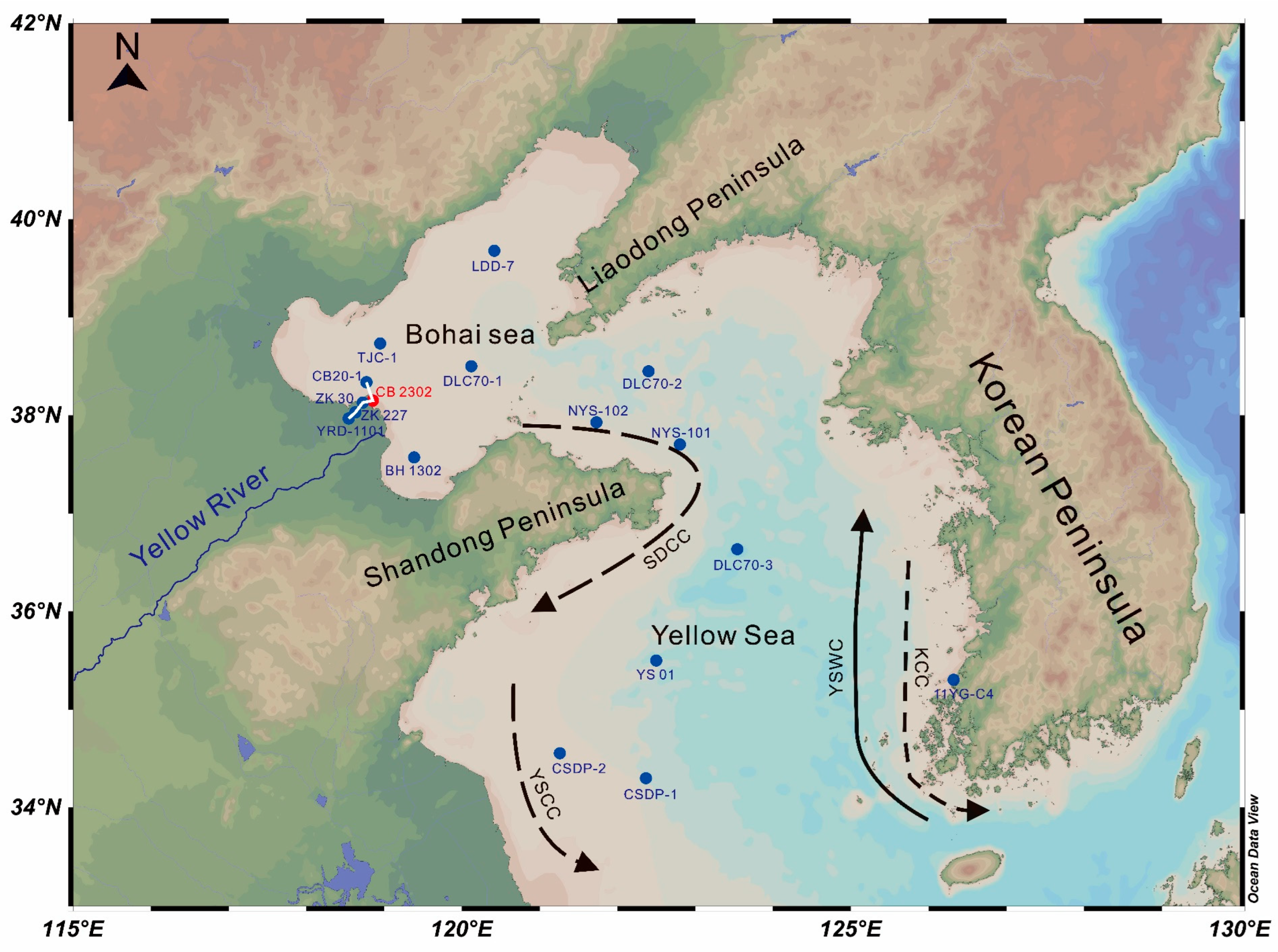
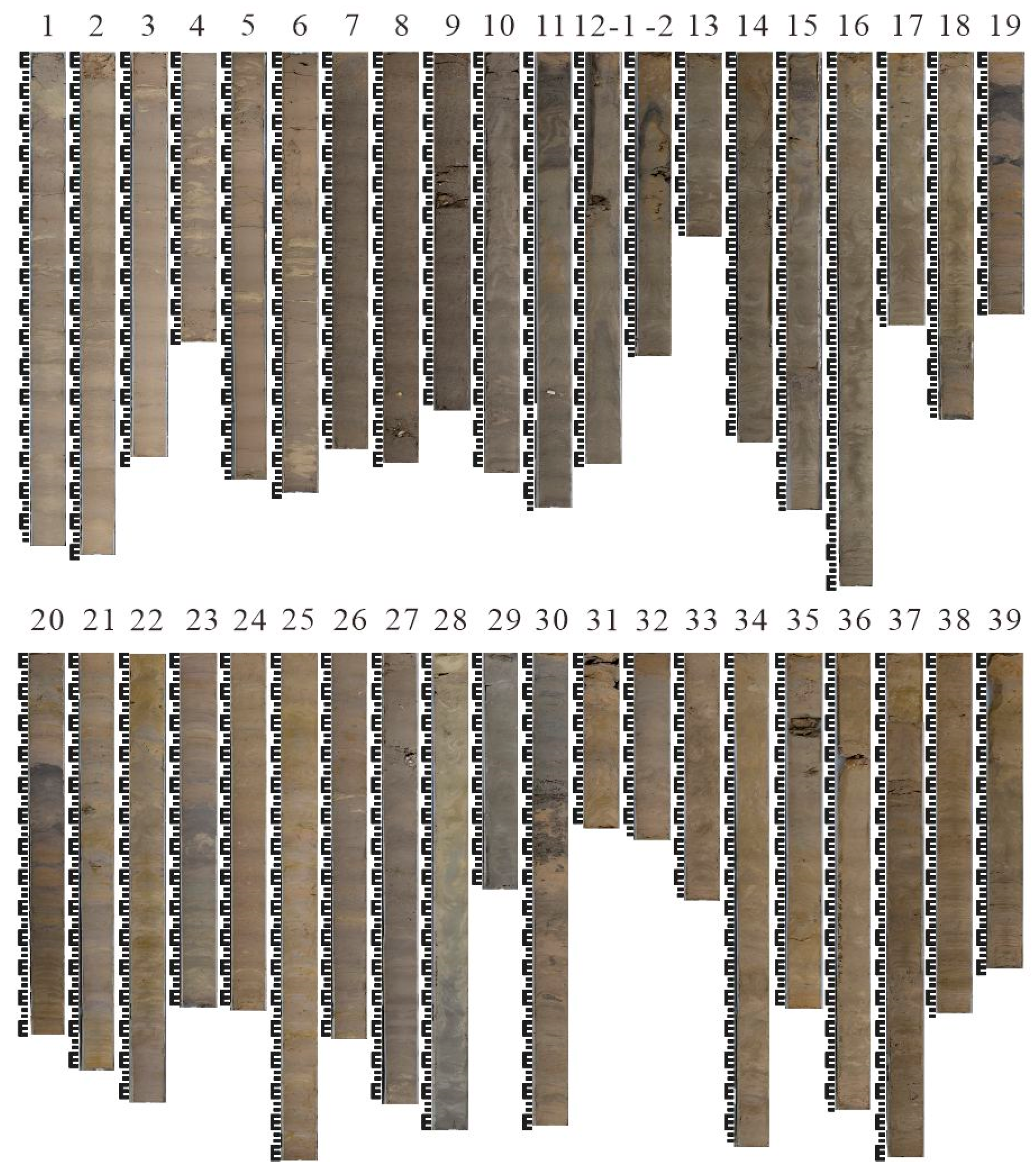

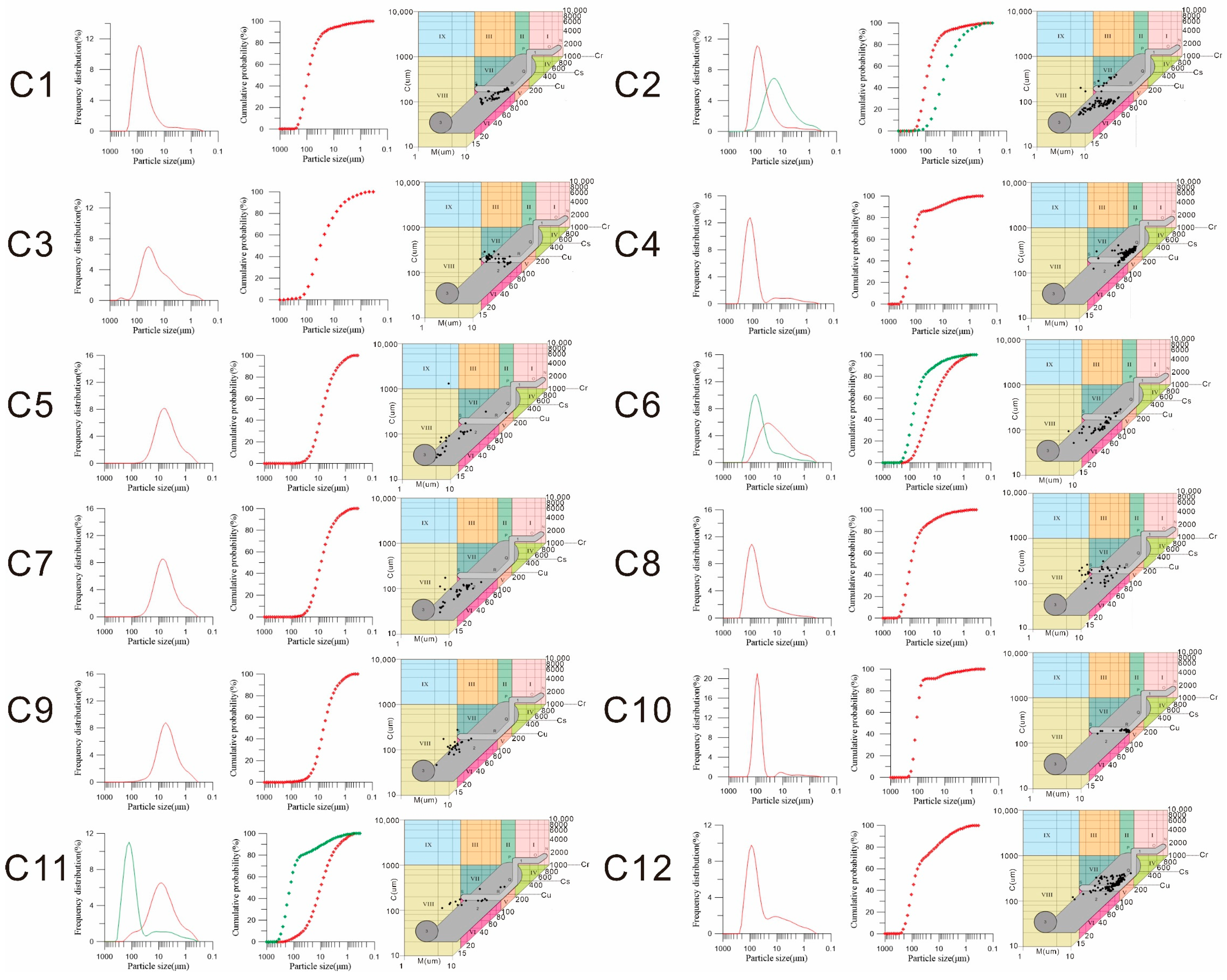
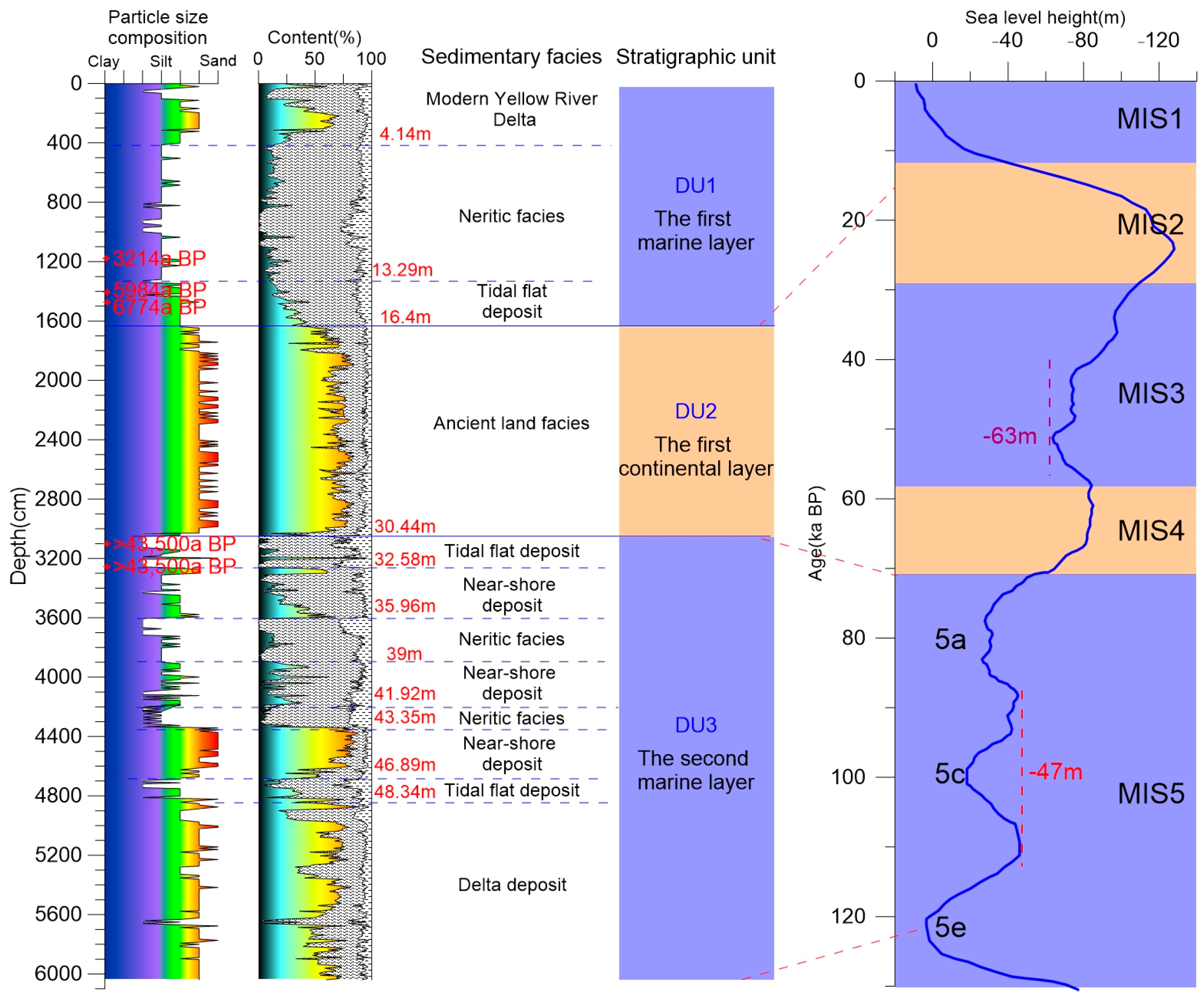
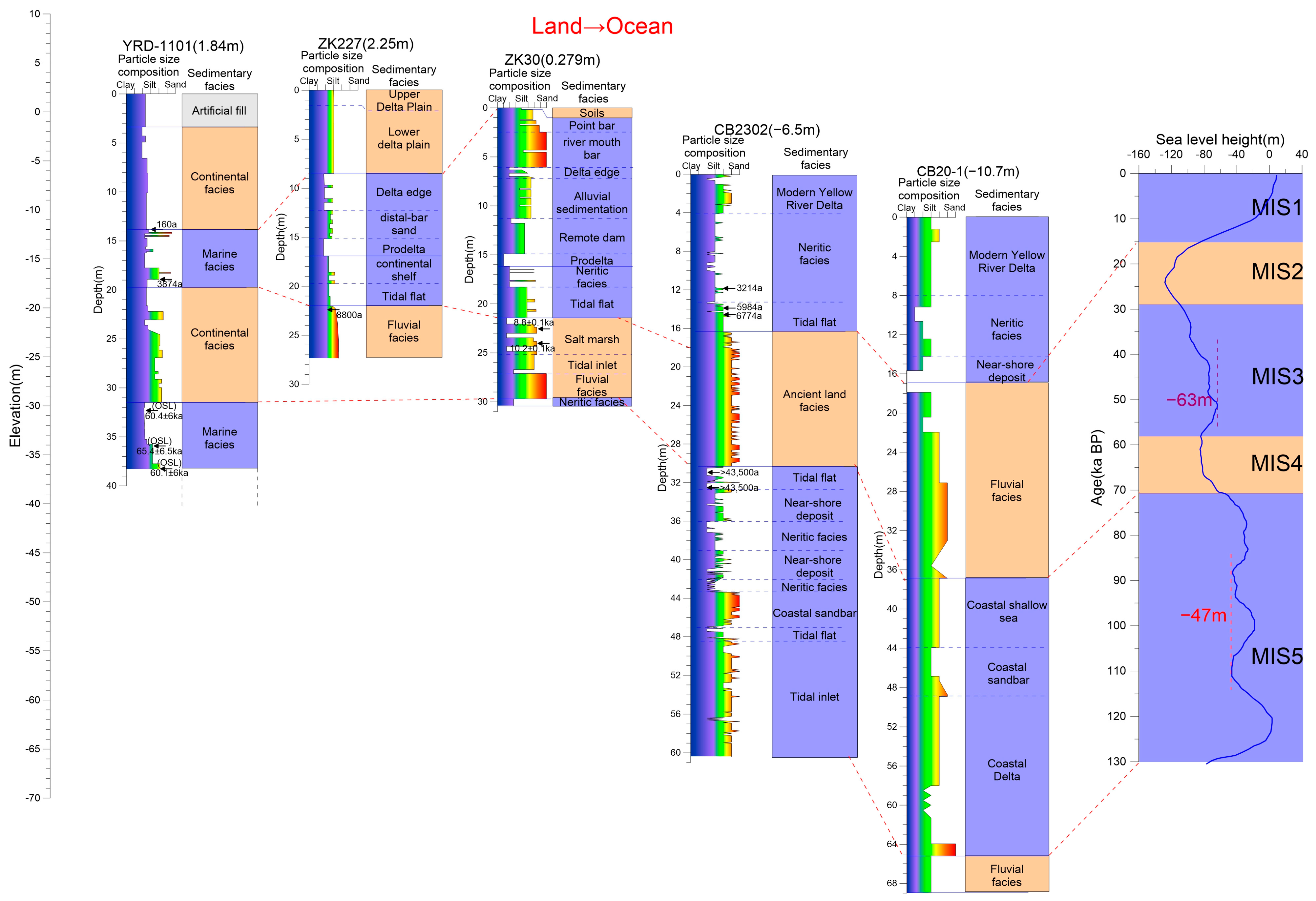
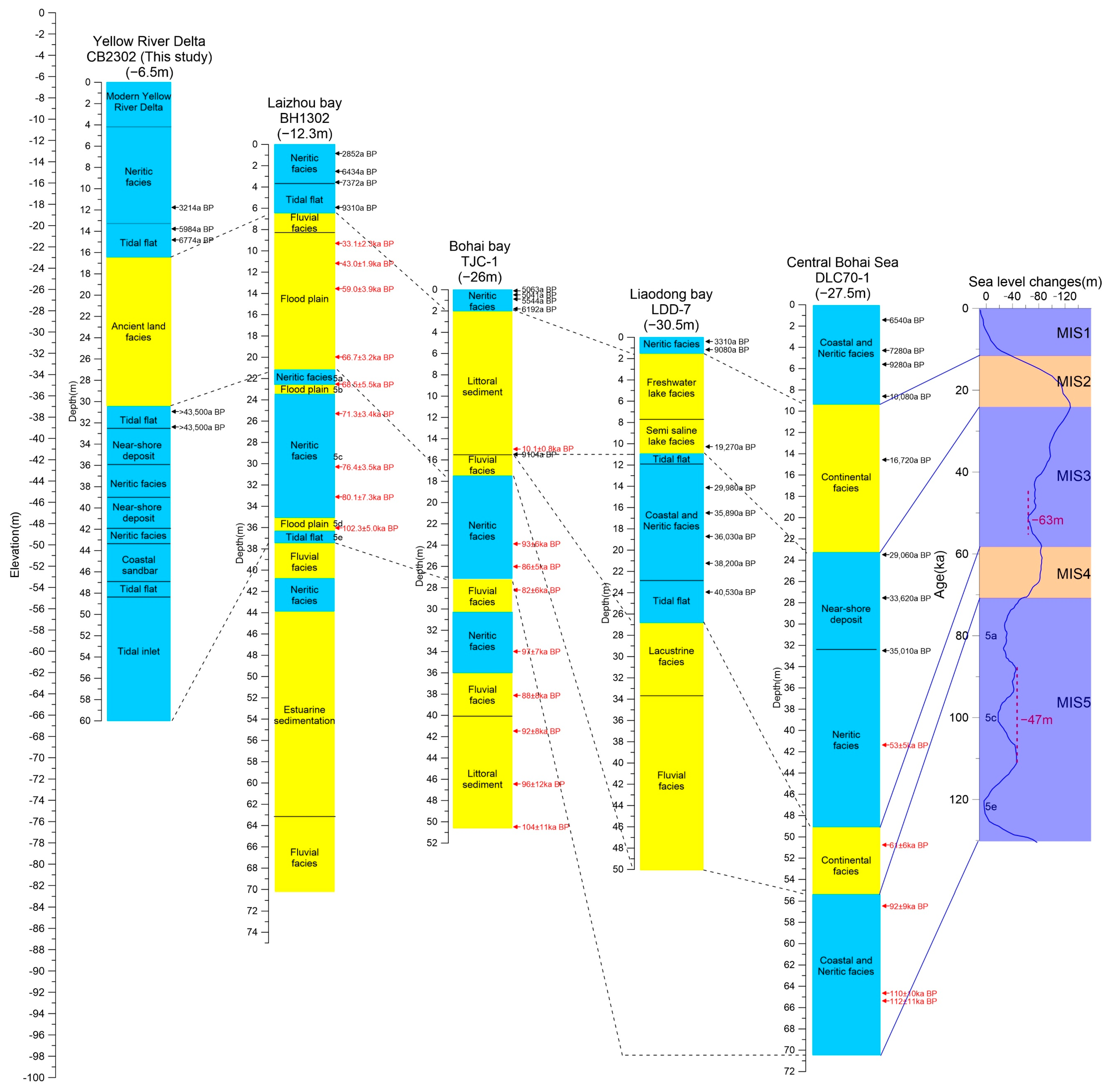
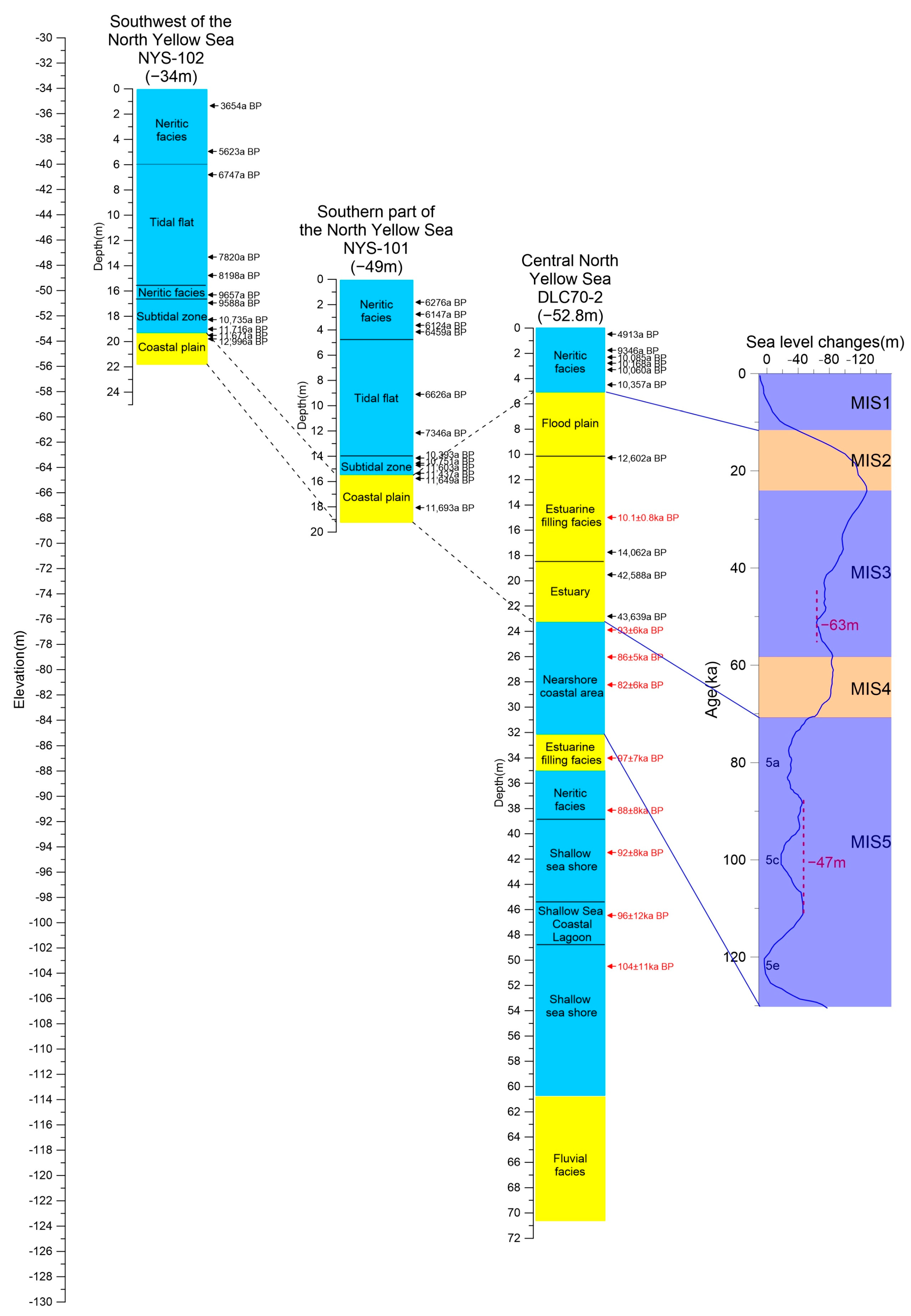
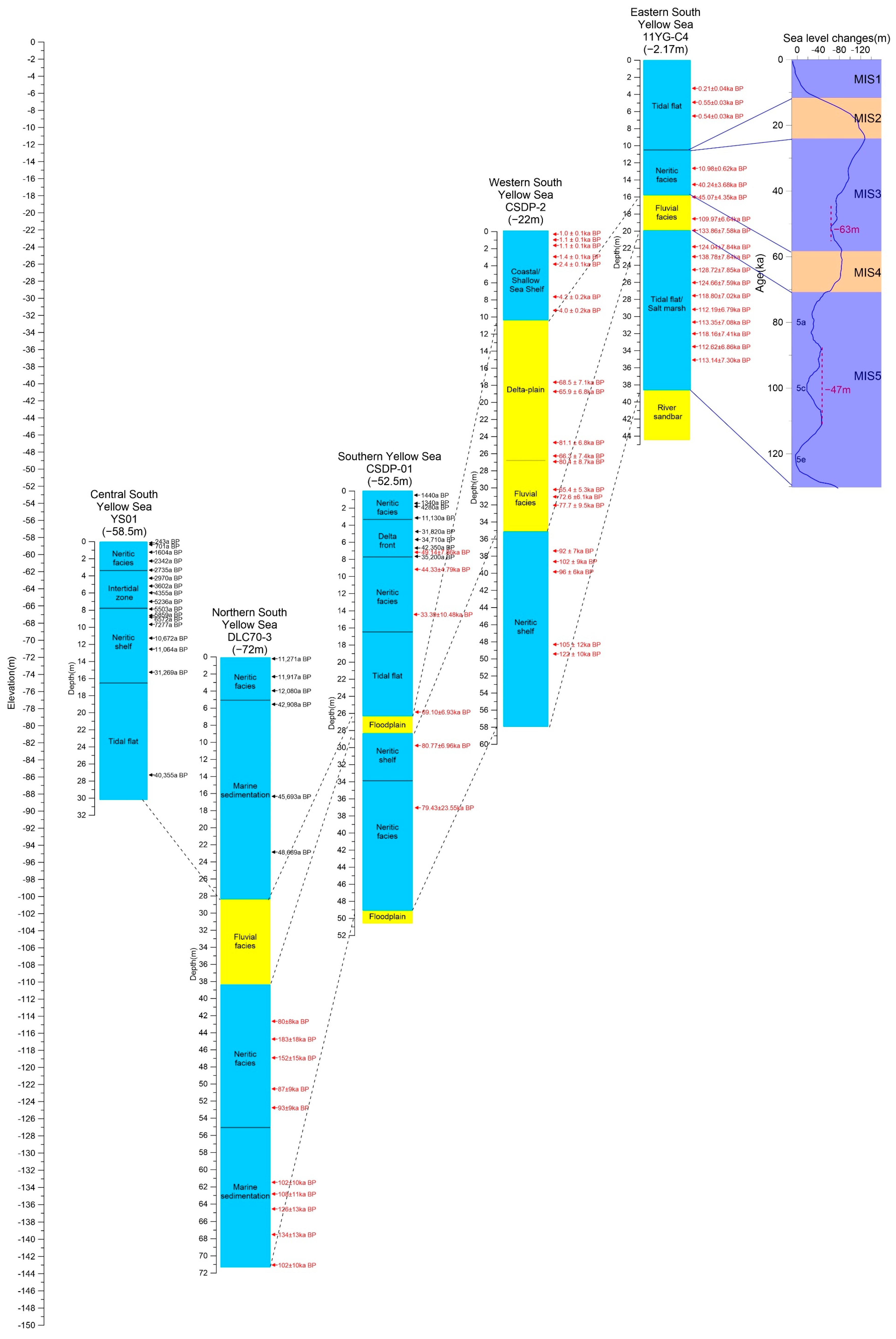
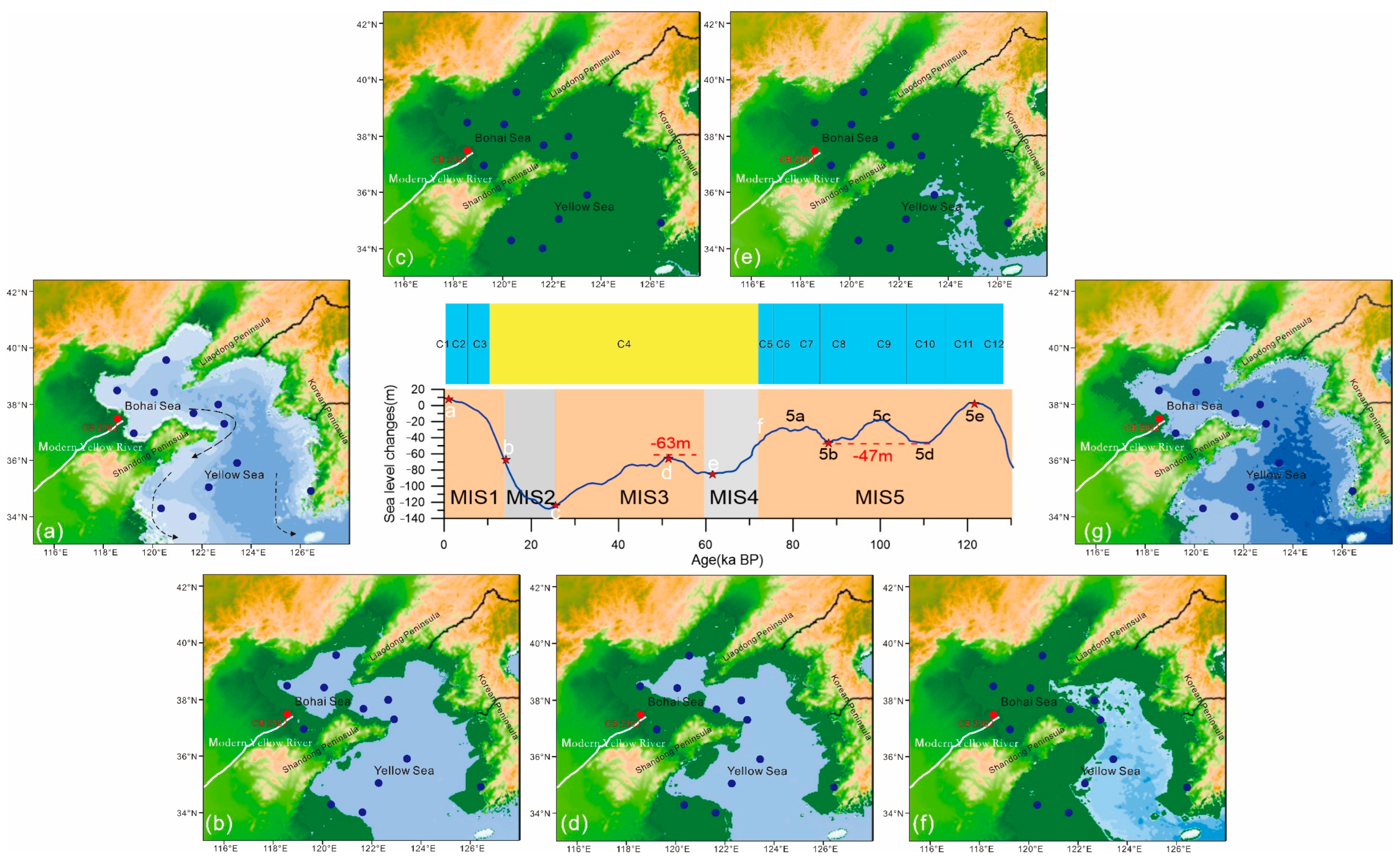
| Test Number | Sample Depth (m) | Test Materials | Test Result (a BP) | Correction Results (a BP) | δ 13C | Date of Test |
|---|---|---|---|---|---|---|
| 680,905 | 11.70–11.80 | Foraminifera | 2880 +/− 30 | 3214 +/− 58 | −1.9 | 5 December 2023 |
| 705,109 | 13.85–13.97 | Foraminifera | 5650 +/− 30 | 5984 +/− 58 | −2.2 | 27 August 2024 |
| 680,906 | 14.59–14.69 | Foraminifera | 6440 +/− 30 | 6774 +/− 58 | −1.8 | 5 December 2023 |
| 680,907 | 30.84–30.94 | Shell fragments | >43,500 | −6.1 | 5 December 2023 | |
| 680,908 | 32.41–32.49 | Shell fragments | >43,500 | −4.0 | 5 December 2023 |
Disclaimer/Publisher’s Note: The statements, opinions and data contained in all publications are solely those of the individual author(s) and contributor(s) and not of MDPI and/or the editor(s). MDPI and/or the editor(s) disclaim responsibility for any injury to people or property resulting from any ideas, methods, instructions or products referred to in the content. |
© 2025 by the authors. Licensee MDPI, Basel, Switzerland. This article is an open access article distributed under the terms and conditions of the Creative Commons Attribution (CC BY) license (https://creativecommons.org/licenses/by/4.0/).
Share and Cite
Li, H.; Li, G.; Zhang, J.; Yang, J.; Xing, L.; Ji, W.; Liu, S. Evolution of Stratigraphic Sequence and Sedimentary Environment in Northern Yellow River Delta Since MIS5. J. Mar. Sci. Eng. 2025, 13, 832. https://doi.org/10.3390/jmse13050832
Li H, Li G, Zhang J, Yang J, Xing L, Ji W, Liu S. Evolution of Stratigraphic Sequence and Sedimentary Environment in Northern Yellow River Delta Since MIS5. Journal of Marine Science and Engineering. 2025; 13(5):832. https://doi.org/10.3390/jmse13050832
Chicago/Turabian StyleLi, Haonan, Guangxue Li, Jian Zhang, Jiejun Yang, Lvyang Xing, Wenyu Ji, and Siyu Liu. 2025. "Evolution of Stratigraphic Sequence and Sedimentary Environment in Northern Yellow River Delta Since MIS5" Journal of Marine Science and Engineering 13, no. 5: 832. https://doi.org/10.3390/jmse13050832
APA StyleLi, H., Li, G., Zhang, J., Yang, J., Xing, L., Ji, W., & Liu, S. (2025). Evolution of Stratigraphic Sequence and Sedimentary Environment in Northern Yellow River Delta Since MIS5. Journal of Marine Science and Engineering, 13(5), 832. https://doi.org/10.3390/jmse13050832





